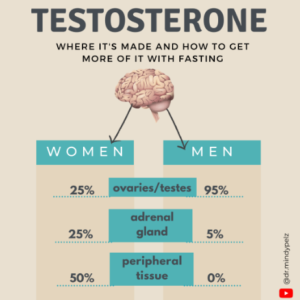When I talk about the hormone testosterone, clients often think the topic only applies to men, however testosterone plays an equally important role in women. Common symptoms of low testosterone in women can look like depression and mood swings, low libido, muscle loss or an inability to put on muscle.
How does testosterone get made?
This is a good question, because men and women make testosterone in different parts of the body. But the signaling system for both men and women starts in the brain. The brain, specifically the hypothalamus and pituitary gland sends a message down to the ovaries (if you’re a woman) and the testes (if you’re a male) to tell those organs to produce testosterone.
However, for a woman, only 25% of testosterone is actually made in the ovaries, with the other 25% coming from the adrenal glands and the remaining 50% coming from the peripheral tissues. These are the same tissues that can cause joint inflammation and insulin resistance. Because so much of testosterone creation is dependent on healthy peripheral tissue, it is critical it is for women to reduce overall inflammation in order to make sufficient testosterone. In summary, for women, the brain, ovaries, adrenals and peripheral tissue all have to be working properly and in sync to support healthy testosterone.
In comparison, men make 95% of their testosterone in the testes, with the remaining 5% made in the adrenals. So for men, the process is more straightforward than women, men need only the brain and the testes to be healthy to support this process.
The role of adrenals
Let’s compare the role adrenals play in men versus women. Since 25% of women’s testosterone is made in the adrenals while only 5% for men come from the adrenals, you can see how stress might affect the sexes differently. Women are much more susceptible to throwing off testosterone production if their adrenals are under stress. Because men only produce a very small percentage of testosterone in the adrenals, they are not as influenced by stress.
Also, menopausal women will need to be extra careful about testosterone levels as the ovaries begin to shift their role during menopausal years and after. Remember 25% of testosterone is made in the ovaries. So menopausal women will need to take extra steps to support testosterone production in the other organs to ensure sufficient testosterone is being made during menopausal years.
“The takeaway is that stress is a hormone killer for women, especially for testosterone.”
So, how can we use fasting to heal these organs?
Fasting for the brain and adrenals
The brain loves ketones. You can get this through Intermittent Fasting. Another great fast for repairing neurons in the brain is Autophagy Fasting. Healthy neurons are critical for the brain signaling system to the organs, which kicks off the whole hormone production cascade. The key to Autophagy Fasting is keeping protein under 20g, and breaking your fast with fat and see if they can go a little bit longer in their fasting, ideally between 17-72 hours of fasting.
Hands down, the best fast for adrenals and adrenal fatigue is Intermittent Fasting. The goal here is to create a hormetic effect that pushes the cells to repair and adapt. Watch my video on how you should fast for adrenal fatigue.
Hormonal organs
Hormonal organs do really well with feast-famine cycling, which adds variation and hormetic stress, keeping hormonal organs on their toes. There is an art to going in and out of fasting, which is why I teach this advanced concept in my Reset Academy.
To bring down inflammation, we again apply Intermittent Fasting, which was shown by the New England Journal of Science to have a number of health benefits. According to the article intermittent fasting can help with cognitive decline, stabilize blood sugar, reduce blood pressure, cholesterol and chronic inflammation.
Now if you’re wanting to know whether testosterone is an issue for you, I’m a big fan of the Dutch Test, for both men and women. It’s an effective tool for eliminating the guesswork and dialing in your fasting and diet according to your unique hormonal needs.
Dr. Mindy’s 3-3-1 Protocol for Testosterone:
- 3 days a week of Intermittent Fasting with Ketobiotic meals. Ketobiotic meals entail eating 50g of protein, 50g net carbs and getting 60% of calories from good fats. I recommend using the Carb Manager App to calculate your macros.
- 3 days a week of Autophagy Fasting
- 1 day a week feast day, specifically eating foods that support progesterone since it is linked to testosterone. These are things like pumpkin, squash, beans, seeds and tropical fruits.
Also, if you missed my other videos on how fasting can help your hormones, check out my Hormone Playlist, where I talk about progesterone and estrogen.
RESOURCES
- Reset Academy: https://resetacademy.drmindypelz.com
- Dr. Mindy’s Facebook Page: https://www.facebook.com/drmindypelz
- Dr. Mindy’s Facebook Group: http://bit.ly/Resetters












The more fasting I do/ the long fasts the more abdominal fat that I notice. Suggestions?